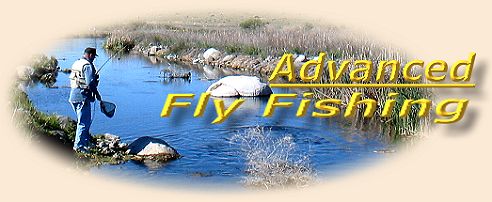|
I have a season ticket on the wonderful Wharfe River
at Bolton Abbey in North Yorkshire which is only 20
minutes from home and one of the best rivers in that
county. Over the past couple of years this has been
my home for fishing.
Just recently I was fishing a particular section of the
Wharfe and I remember a rather special fish. I had just
made a perfect cast to my right which I knew would allow
the flies to sink in the water before swinging upwards
through the current. Making sure that my rod did not get
in front of my line I concentrated on the feel of the line
as it begun to swing across and upwards through the current.
Was that a touch? Did I perceive a small slowing of the
line? I pulled firmly, but not too hard, against the line
and felt the weight of something on the end. A fish exploded
through the surface. I had him. A 3lb brown trout.
I had seen this fish taking emerging Baetis mayflies some
20 minutes before. I had noted where he was laying and had
worked my way slowly down the run picking up a couple of
smaller fish on the way before I prepared to 'trap' him
with my flies.
The small 'spider' patterns that I had been fishing had
done their job again. Just as they had on the other dozen
or so fish I had caught that day. And there was still a
lot more fishing to be had yet. Why had I not used them
at home in Australia?
This season I have been concentrating on learning and using
the 'spider' patterns of northern England. The season has
now been open for 3 months and I have already fished more
than I would in a normal season. Due mainly to the fact that
work commitments have not been as intensive as normal.
What is a 'spider pattern'? A 'spider' fly is defined as 'a
soft hackled pattern, rarely with wings'. These flies are not
intended to represent a natural spider. The term 'spider' was
probably inherited from Scotland and was a tradition made
famous by W. C. Stewart (more about Stewart later).
'Spider' patterns were used exclusively by the fly fishermen
of the northern parts of England for some time before venturing
further afield. Indeed, you do not see them very often in tackle
shops or featuring in fishing articles. These mediums of fly
fishing seem to dispense with the old traditional flies and
concentrate of the more modern fly patterns and their myriad
of variations.
Do 'spider patterns' work? When fished properly they are deadly
and if the weather conditions are right it is not unusual to
catch many fish in an outing. In a four-day period recently
where I was able to get out fishing each day and I had been
able to catch and release over 100 fish in a five-mile stretch
of Wharfe.
Soft hackled flies first appeared in the Compleat Angler
when Charles Cotton wrote his famous book in 1676. Indeed, it is
likely that they were around for some time before Charles Cotton
as the patterns and materials used at that time probably meant
that 'soft hackled' flies were in use even in the Roman occupation
period.
Apart from some writings by James Chetham in 1681, new works on
angling were almost non-existent for two centuries. Soft hackled
flies were again introduced to anglers in 1816 when G. C. Bainbridge
wrote The Fly-fishers Guide. Another 60 years were
to pass before three more valuable works featured soft hackled flies.
W. C. Stewart wrote The Practical Angler; W. H. Aldham
A Quaint Treatise on Flees and the Art of Artyfichall Flee
Making in 1876; T. E. Pritt Yorkshire Trout Flies
in 1886 (which was re-titled North-Country Flies in a
later edition). All these books featured extensive writings on soft
hackled flies. But in 1857 the greatest influence on using these
patterns in England occurred. W. C. Stewart was a renowned fly
fisherman from the Scottish Border area and it was Stewart that
put 'spider' patterns in the fly box of all the north of England
fly fishers in the late 19th and early 20th centuries.
It was to be another 80 years before a major writing on the use
of soft hackles was to emerge. During that time there were many
references to these patterns. Macintosh, Ronalds, Skues and others
all reference the use of these patterns and the characteristics
of soft hackles.
In 1949, the great American angler James E Leisering wrote The
Art of Tying the Wet Fly which was added to by his long time
fishing friend, Vernon Hidy, and released as The Art of Tying
the Wet Fly and Fishing the Flymph.
The soft hackled fly, aka the 'spider' or 'flymph' had arrived
into the modern era of fly fishing. A synopsis on the soft
hackled flies can be read in The Art of the Wet Fly
by W. S. Roger Fogg (1975).
So apart from the northern rivers of England, why do we not see
or use them? Tony Brothers is the only person I know who uses
some of the patterns in Australia. I never see them in tackle
shops, nor in fishing articles or in the fly boxes of other
anglers yet they are tremendously successful. Some fly fishermen
in England never use any other pattern, preferring to change
spider patterns depending on the time in the season, water
conditions and temperatures.
They can be a complete fly representing an emerging insect, a
drowned dun or a nymph (depending on where the fish sees it),
or an emerging caddis and they are very deadly in the hands of
an experienced 'spider' fisherman, yet they are an extremely
simple fly to tie. Is it that we anglers are always trying to
seek something very special - a fly that we can call our own
and one which, if all other fly fishers used it, would make us
famous? Is it that we simply want to experiment and create our
own patterns and enjoy their successes and failures (probably
more of the latter)? Are we not confident enough in our own
fishing ability and are led by others who we believe are better;
therefore we use or make many patterns that they use in order
to be successful? Or is it that something so simple is difficult
to believe it will catch a fish?
It is interesting to note that we do trust some of the
traditional patterns. Who would not be without a 'Red Tag'
in Tasmania; a Brown nymph on the lakes around Ballarat;
or many of the other patterns that are successful on
specific waters? So why is it that flies designed thousands
of years ago, fished extensively on rivers similar to those
in Australia, are the favourites of world class fly fishermen
and which are very deadly, are excluded from our fly boxes?
I do not have ready answers these but I can let you know how
to tie and fish them successfully. I can tell you that I am
now a convert to 'spider' fishing.

The dressing of Spider patterns is very simple. The only
two difficulties are (a) making sure that you don't use
too much body material and (b) tying soft hackles onto
the hook.
These flies are sparse and I mean very minimalist in appearance.
So you will need to conquer a few natural tendencies to
overdress the patterns. They only work well when tied correctly.
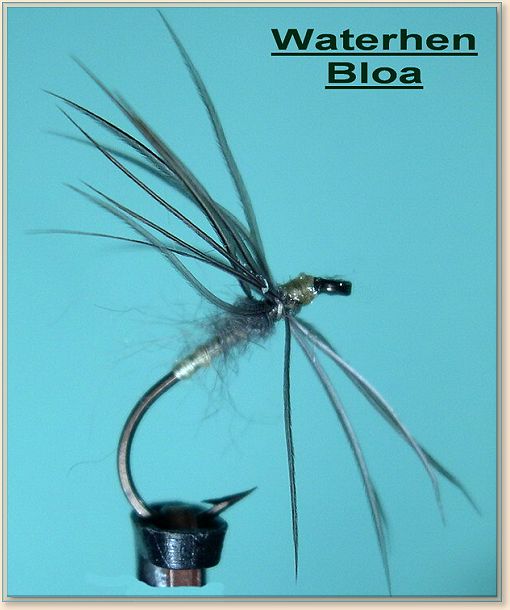
Hooks are generally very small and in sizes 16 - 18 of
normal length. You can use either light or heavy gauge
hooks. I use both as sometimes I want the fly to drift
in the surface and get this effect with a lighter hook.
You can go up in size but no bigger than a size 12. I use
these sizes when I see large duns or caddis emerging. I
believe that we use too large a hook anyway. If you want
evidence of this then you only need to cast out a size
12 dry fly on the lakes in Tasmania when duns are hatching.
You will easily see your imitation mixed in with the naturals.
If you think the hooks are small, then the body is even
smaller. In these patterns the body commences in line with
the point of the hook never longer, and the thickness of
the body is kept slim for translucency. If you want to
read about translucency on flies then you should read
J. W. Dunne's (1924) Sunshine and the Dry Fly.
There is definitely something to learn from these old masters.
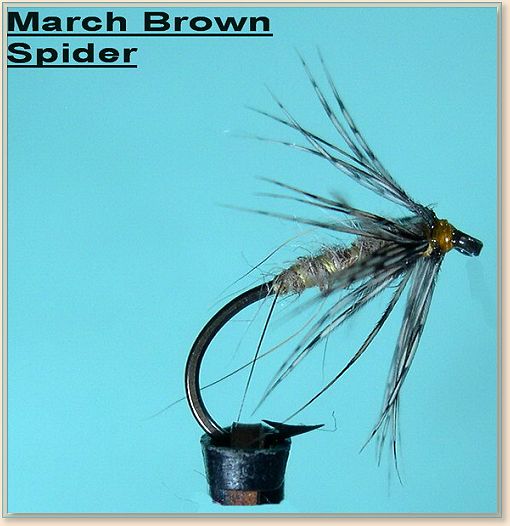
The materials used can vary from just tying thread,
dubbing or feathers. The thread used must be a close
resemblance to the underside or abdomen of the insect
that you are trying to imitate. For a dun it would be
a pale yellow/green or pale brown. For a caddis it
would be more yellow. Now is the time to get out your
insect catching materials or look under rocks to determine
the right colour. They do vary between insects and waters
or even within waters. The thread is taken down to the
hook to immediately above the hook point. If you are
simply using tying thread to form the body, then you
take it back up the hook to the point where you would
tie in a hackle. In this case neat turns are required.
If the pattern calls for dubbing then the tying thread
is dubbed before it is returned to the hackle location.
Now this is the first challenge. Make the dubbing very
sparse. You must be able to see the thread through the
dubbing. If you think it is about right, then it's a
good bet that you have too much. I cannot stress enough
the need to use only a very small amount of dubbing. On
my flies (and those of the traditional patterns) a dubbed
pattern is only marginally thicker than a pattern where
tying thread has been used. Dub the material up to the
point where you will tie in a hackle. Some of the dubbing
commonly used is Hare's Ear (used in the March Brown Spider),
Mole (used in the Waterhen Bloa) & Seal's Fur. Recently I
have been using the under fur of a possum skin over a
'Greenwells' coloured thread (obtained by pulling the
thread through beeswax).
If you are to use feathers, be frugal in the amount you
use. Common feathers used for a body are Peacock, Pheasant
Tail and Heron. Recently I have also used CDC feathers
which can provide a very buoyant body.
Now for the next challenge. The key to the success of these
flies is movement. Therefore the hackles will be very soft
and longer than those used in common wet flies or dry flies.
This should give us a guide on what feathers to use.
Traditional flies used Lapwing, Plover, Dotterel (all
three now difficult or impossible to obtain) Pheasant,
Grouse, Partridge, Starling, Snipe (again difficult to
obtain), Woodcock and Waterhen. In addition there is a
frequent use of hen and game cock hackles. In earlier
times (and when some of these birds were more prolific)
the feathers were probably obtained from dead birds
located during a days fishing or individual feathers
that a live bird has lost. I have yet to discount other
types of birds, for example the breast feathers of a
'Shellback' duck, or a longish collar of possum fur.
Correct hackling of a 'spider' pattern is very sparse.
One or two turns at the most. The only variation would
be when a hen or game cock hackle is used. Feathers are
tied in at the tip end and wound around the hook. Again
I cannot stress enough the need to be frugal. If you feel
that you need to take one extra turn then it's a sure bet
you will put too much hackle onto the hook. A trick I use
is to strip one side of the feather and then wind two
turns for a game bird (e.g. Grouse or Partridge) and
three turns for a hen hackle. This works fine.
There are plenty of old books featuring soft hackled flies,
you need to read them and try a few. Typical patterns are:
Snipe and Purple, Waterhen Bloa, Orange and Partridge (these
three patterns are used predominantly by the 'die-hard'
spider fishermen of the north country), Greenwell's Spider,
Pheasant Tail, March Brown and many more. But you can
personalise these by matching the insects. I have been using
what I refer to as the 'Possum and Partridge' which is a body
of possum with a partridge hackle and 'Greenwell's' coloured
tying silk. This pattern has accounted for the 100 plus fish
I took over the 4 fishing days.
Fishing 'spider' patterns is almost as simple as the flies
themselves when explained briefly - cast across and let them
swing back downstream. But in effect it is a real skill and
once mastered and used with small sparse flies it is very
deadly. Be aware though that the fish tear these flies apart
and you will need a few of them, especially those using Partridge
or Grouse. Just as well they are a simple and quickly tied fly.
To fish these correctly you must have both the right outfit
and approach. Rods must be no shorter that 8'6" and anything
over 10' is too long. Lines should be floating and can be
either a double taper or weight forward. I prefer a weight
forward as it loads my rods faster when casting short lines.
Leaders need to be a little longer than normal and be able
to hold multiple flies. I use a 10' to 12' leader with a
dropper. Some fly fishermen use three flies and I have used
both two and three flies but have not noticed any difference
between them. Anyway, two flies are enough to control.
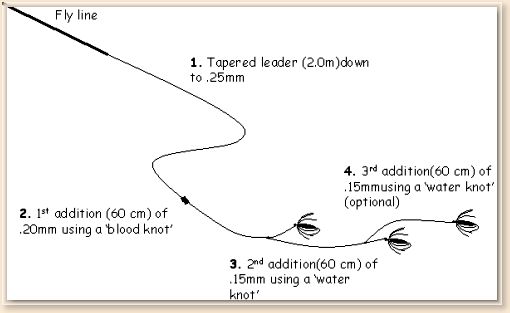
When fishing in Australia I have always made my own leaders
and still prefer to do so. The trouble here in England is
that it is difficult to get the right thickness for butts
and next two sections. So I use a 9' tapered leader with a
3lb breaking strain point from which I remove the bottom
third. I then attach a 3 foot piece of 8lb leader material
of .25mm thickness using a normal knot; in my case a blood
knot. To this I attach a further 3 foot piece of 6lb leader
material which is about .15mm thick. In other words double
strength leader materials. I attach this using a water knot
and make sure that at least a 4 - 5 inch piece of 8lb leader
protrudes from the lower side of the finished knot. Clip off
the tag on the upper side. This enables you to attach two
flies to the leader. If you want to try three flies then use
a water knot for the first section or attach another section
using the same method.
Spiders can be fished upstream or downstream. W. C. Stewart
was an advocate of the upstream approach and Leisering of
across and down but they are mainly used downstream by
modern anglers. I use them in three situations - downstream
searching or targeting specific fish, upstream to a rising
fish - and they work in all three.
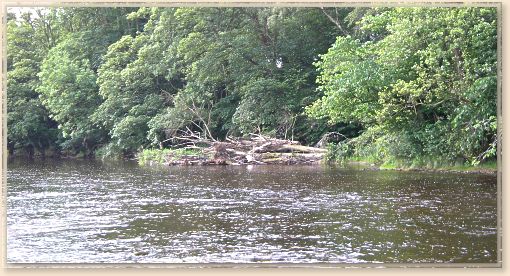
Good water. The prime run is to the right of the picture.
To fish this particular stretch you would position yourself
in the middle of the stream which would allow you to cover
both sides. Four fish were taken in this stretch in one
session.
The downstream searching approach is where spiders are
deadliest. The method is easy but very specific in technique.
Only two rod lengths of fly line are required beyond the rod
tip. Any more and you begin to lose contact with the flies.
Therefore it is probable that you will be doing some deep
wading to reach the right type of water. The use of spiders
is not too effective in fast rapids. It is in its element
in the strong flows immediately upstream or downstream of
a riffle or fast water but is still effective in the slower
sections of a stream. So you need to position yourself where
the water to be fished is right up against your casting side.
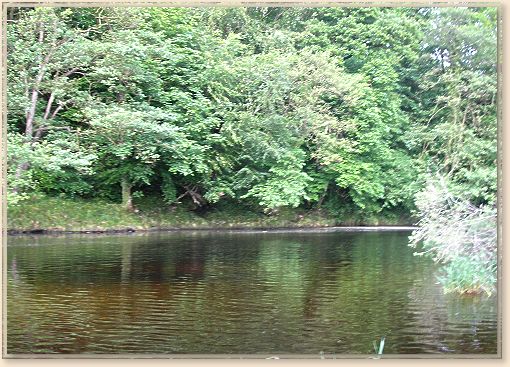
Slow glide below the above fast flowing water. Spiders do
work in this type of water but I would probably leave this
and move on to faster water. An option is to drift a 'dry'
on the point down the far side and leave the 'spider' on
the dropper.
The flies are cast at a right angle from where you are standing
and directly across the current. This can be reduced to between
45° and 90° in the slower sections. It is important that you
mend line to ensure that the rod remains behind the flies.
You must keep the rod behind the flies at all times so you
need to watch the speed at which the leader travels. Do not
mend the line once the cast has been made as this will alter
the drift of the flies. You can move the rod to the opposite
side of your casting arm if you want to extend the drift.
Hold the rod high. This means that the rod tip will be above
a 45° angle to your body and high enough to ensure that only
about 2' of fly line sits on the water. You should notice
that there is a very large curve in the fly line from the
tip of the rod to the water. This curve is the secret to
catching fish. The way in which the flies move in the water
means that the takes are very soft and if the rod is lower
it will result in a lot of short takes and missed fish.
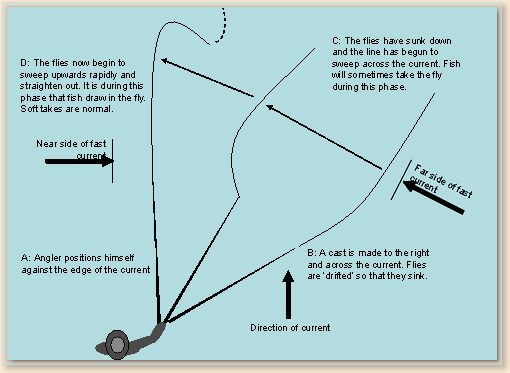
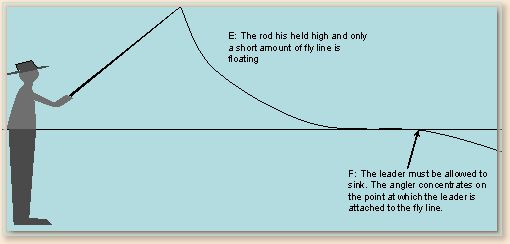
Once the cast has been made, allow the flies to sink 'dead
drift' in the current. They should drift for 7 - 10 yards
before sweeping across the current. Keeping the rod high
and only having a small length on fly line on the water
helps this. As the current begins to take control, the
flies will swing across and upwards through the current
which in turn imparts movement into the fly. Exactly what
the flies are designed to do. You must be alert as a take
can occur at any point during this latter stage. Concentrate
on the point where the leader and fly line join. I keep the
fly line in my left hand right through out the cast and more
than often can feel the take before I see any change in the
leader.
If you think you feel something or observe a change in line
speed, then lift. Takes are quite varied, sometimes they are
very vigorous and right near the surface, other times it will
be a slight pull on the line. Don't strike hard. A steady lift
is all that is required and keep the rod high or you risk
losing the fish. If there is no take, then repeat the cast
and take one step forward. The step forward means you are
covering new water and will also help the flies to sink.
The other two situations still require the same technique
but differ slightly. For a fish that rises in front of you
while you are fishing downstream, then quietly approach the
position where the fish was observed and make a cast about
45° across, in front and to the far side of where the fish
moved. Where an upstream cast is required you make a cast
similar to that made with a dry fly. I also grease the line
right up to the fly in these situations.
So there you have the 'spider' patterns of northern England
and how to fish them.
Would these flies and fishing technique work down under? I
am convinced that they will. The streams that I have fished
here in England are very similar to the majority of streams
on the Australian mainland and in Tasmania. Freestone Rivers
with runs, riffles, deep pools and long flat stretches just
like the Mitta Mitta, Goulburn, Swampy Plains and the rivers
of Tasmania.
Why not try it? You might be surprised. Oh by the way! Why
not try fishing barbless? It is fast becoming the rule in
the UK, anyway it is easier to return fish and your catch
rate is not affected.
Cheers from the north and if you want to contact me my
e-mail address is philipbailey@ozemail.com.au. Or
pbailey@rcpglobal.com and my phone number is
+44 7811 286652. I might just want a fishing companion
if you are over here. ~ PB
About Philip Bailey:
Philip has a managerial and consulting background in Financial
Services for over 35 years and works globally with companies
to improve their performance.
Philip spent a short period outside of the Financial Services
Industry as owner of a small fishing tackle shop and Professional
Fishing Guide leading clients on wilderness excursions in Tasmania.
During that period Philip acted as a lobbyist on behalf of
Recreational Angling and was a key member of the task force which
established the Peak Angling body for the Australian State of
Victoria. Philip served as an inaugural board member on the
body which represented nearly a million recreational fishermen.
During this period, effective lobbying removed the devastating
effect of Scallop dredging in bays and inlets around that state.
Founder and inaugural chairman of the high profile lobby group,
The Australian Trout Foundation, Philip was one of a small band
who were responsible for the return of a closed season and bag
limits for the Victorian Trout Fishery.
Philip was also a key member of the advisory group to the Minister
responsible for Fishing in the Australian state of Victoria for
the establishment of a Peak Angling body representing 1 million
recreational anglers and was an inaugural board member representing
300 thousand trout anglers.
Born in Mildura on the Murray River, Philip began fishing at
the age of three and moved into fly fishing nearly 30 years
ago. An accomplished fly fisherman Philip has also been
President of the Victorian Fly Fishers Association, President
of the Council of Victorian Fly Fishing Clubs, a recipient
of the Councils award for recreational fishing and the Norm
trophy from Greenwells Fly Fishers.
Currently he is working in the United Kingdom as a Management
Consultant in the Financial Services industry.
|
